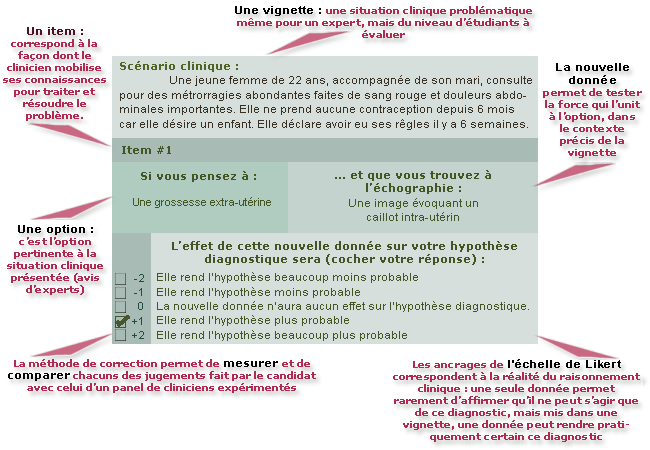Start by gathering together all the material constructed in the three previous steps:
- Objectives of the assessment;
- Specification table including the evaluation fields of knowledge of your SCT;
- Clinical vignettes and items
There is not only one way of presentation of the SCT. However, there is one rule that must be respected: it should integrate the components of an evaluation unit:
- Vignette ;
- Items (option and new information) ;
- Likert scale ;
- Anchor descriptors for each value of the scale.
For instance, 3 evaluation unit formats are presented bellow (see icons). Each one of them responds to a different need and way of organizing the information, but they all enable the activation of scripts (networks of organized knowledge) to process information and progress toward solutions to real clinical problems.
- Diagnosis evaluation unit that comprises 1 item (1 simple vignette / 1 question)
- Treatment evaluation unit that comprises 3 items (1 complex vignette / 3 independent questions)
- Unit based on 2 evaluation fields; informs about the evolution of the situation (1 vignette / questions about investigation + 1 complementary vignette / question about the treatment)
You can also enrich your clinical cases with images, sounds or videos.
NB: Experience shows that it is very challenging for students to answer to a test made of only 1 item for each vignette. It is therefore preferable to present more than one item, usually 3, per vignette.
Example of a diagnosis evaluation unit including 1 item (1 question – answer)

Example of a treatment evaluation unit including 3 items

Example of a 2 evaluation fields unit : investigation and treatment
Then, finalize the general shape of the test, and decide the order of presentation of your questions (rf. Step 2: Specification table including the evaluation fields of knowledge of your SCT).
It is very important to set the instructions at the beginning of the test. Bellow, instructions of a test intended for radio-oncology residents.
Instructions
The test contains 30 clinical vignettes of 3 items each. 10 vignettes are about the treatment of patients having pulmonary cancer, 10 others are about the urologic cancers and the last 10 are about breast cancer.
1. Each vignette includes general and incomplete information about the patient.
2. In the first part of each item, we suggest you a possible treatment or diagnosis (see following example)
Clinical vignette:
Man, 56 years old, with a pulmonary non small cells neoplasia T3 N2 in the inferior lobe of the right lung
| If you were thinking of. | And then you were to find. (new clinical finding, physical sign, patient complaint, pre-existing condition, imaging study or laboratory test result) | The treatment becomes. |
| A. High dose chemotherapy and radiotherapy treatment | Right susclavicular ganglia of 2.5 cm | -2 -1 0 +1 +2 |
| B. High dose chemotherapy and radiotherapy treatment | Right malignant pleural effusion | -2 -1 0 +1 +2 |
| C. High dose chemotherapy and radiotherapy treatment | Superior vena cava syndrome | -2 -1 0 +1 +2 |
| -2: Strongly contraindicated; -1: contraindicated; 0: neither more nor less indicated; +1: indicated; +2: strongly indicated |
||
3. The second column contains additional information about the patient presented in the short vignette. What we try to know is whether this new information influences (or not) the option of treatment (or the hypothesis) considered before (in the first column, «If you were thinking of.»).
For instance, if you were thinking of high dose chemotherapy and radiotherapy treatment for this man, and then, it happens that you find him a right susclavicular adenopathy at the physical exam, you may then possibly change your opinion about the treatment you have planned before.
4. A scale is furnished at bottom of each vignette. Encircle the answer that correspond the best to your opinion.
5. Each item is inspired from the vignette, but is also independent from the content of the other items.


